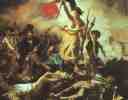![]()
 La Liberté guidant le peuple
La Liberté guidant le peuple
Liberty leading the People (90 Kb); Painted on 28 July 1830, to commemorate the July Revolution that had just brought Louis-Philippe to the French throne; Louvre.
This painting, which is a sort of political poster, is meant to celebrate the day of 28 July 1830, when the people rose and dethroned the Bourbon king. Alexandre Dumas tells us that Delacroix's participation in the rebellious movements of July was mainly of a sentimental nature. Despite this, the painter, who had been a member of the National Guard, took pleasure in portraying himself in the figure on the left wearing the top-hat. Although the painting is filled with rhetoric, Delacroix's spirit is fully involved in its execution: in the outstretched figure of Liberty, in the bold attitudes of the people following herm contrasted with the lifeless figures of the dead heaped up in the foreground, in the heroic poses of the people fighting for liberty, there is without a doubt a sense of full participation on the part of the artist, which led Argan to define this canvas as the first political work of modern painting.
Liberty Leading the People caused a disturbance. It shows the allegorical figure of Liberty as a half-draped woman wearing the traditional Phrygian cap of liberty and holding a gun in one hand and the tricolor in the other. It is strikingly realistic; Delacroix, the young man in the painting wearing the opera hat, was present on the barricades in July 1830. Allegory helps achieve universality in the painting: Liberty is not a woman; she is an abstract force.
excerpt from p. 353-354, Humanites: The Evolution of Values by Lee A. Jacobus, copyright 1986 McGraw-Hill. (thanks to David Good.)